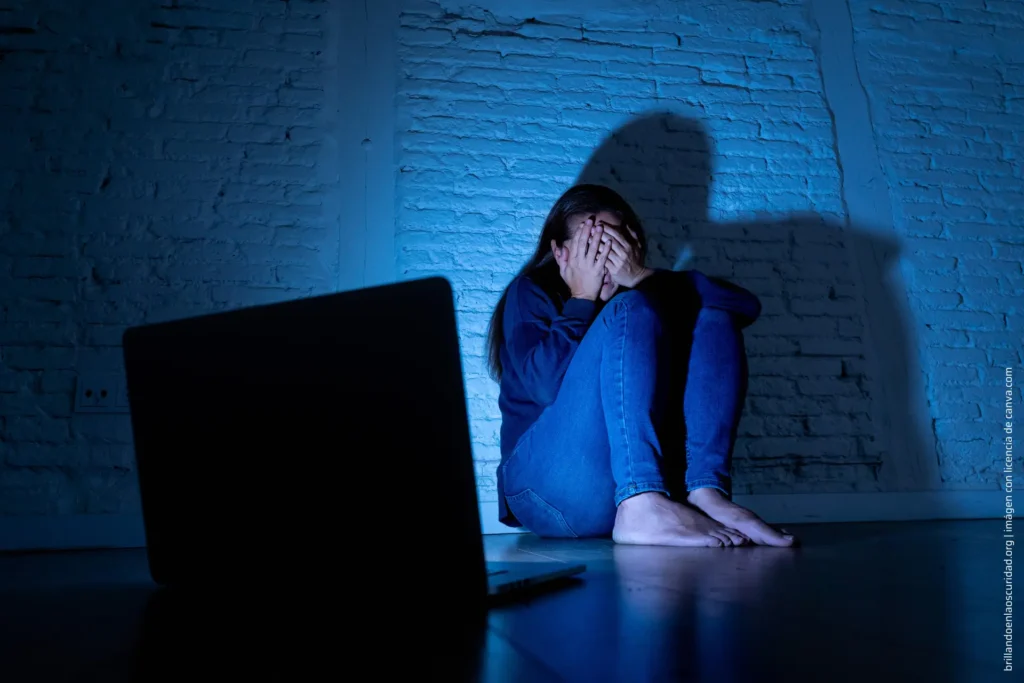Hello, dear readers! Today we are going to talk about a serious issue that affects many teenagers around the world: cyberbullying. This invisible enemy can have a devastating impact on the mental health of young people. Let’s unravel what cyberbullying is, how it affects our minds and, most importantly, what we can do to combat it. Here we go!
What is Cyberbullying?
Cyberbullying, or cyberbullying, is a form of bullying that occurs in the digital world. It can happen through social networks, text messages, emails and any other online platform. Bullies use these tools to send hurtful messages, spread rumors, share embarrassing photos and generally make their victims feel bad about themselves.
The Impact of Cyberbullying on Mental Health
Immediate impact of cyberbullying
The impact of cyberbullying on the mental health of adolescents is immediate and can be devastating.
Anxiety and Depression
Victims of cyberbullying often experience high levels of anxiety and depression. The constant negative messages and fear of being attacked at any time can lead to a constant state of alertness, which is both mentally and emotionally draining.
2. Low Self-Esteem
Constant bullying can make teens feel worthless and worthless. This low self-esteem can affect all aspects of their lives, from their school performance to their personal relationships.
3. Social Isolation
Fear of bullying can lead young people to isolate themselves socially. They avoid social networks, school events, and other activities where they think they might be attacked, which alienates them from friends and the support they need.
4. Physical Problems
Constant stress can manifest itself in physical problems such as headaches, stomach problems and sleep disorders. The mind and body are connected, and what affects one, affects the other.
Long-term impact of cyberbullying.
The Relationship between Cyberbullying in Adolescence and Psychiatric Disorders in Adulthood and Middle Age, and its Connection to Suicide Rates.
Cyberbullying and its Psychological Sequelae.
1. Development of Psychiatric Disorders
Cyberbullying can have a significant and lasting impact on the mental health of victims, leading them to develop various psychiatric disorders in adulthood and middle age. These include:
- Depression: prolonged exposure to cyberbullying can trigger recurrent depressive episodes. The constant sadness and feelings of hopelessness experienced by adolescents may persist and worsen over time.
- Anxiety: Victims of cyberbullying often develop anxiety disorders, including generalized anxiety disorder and panic attacks. The constant fear of bullying can become a chronic preoccupation.
- Post Traumatic Stress Disorder (PTSD): Some adolescents may develop PTSD as a result of the psychological trauma suffered during cyberbullying. Intrusive memories and intense reactions to recalling the bullying can affect their long-term quality of life.
- Eating Disorders: Cyberbullying, especially when focused on the body and physical appearance, can contribute to the development of eating disorders such as anorexia and bulimia.
Impact on Self-Esteem and Social Relationships.
The damage to self-esteem caused by cyberbullying can have long-lasting effects. Victims often face difficulties in their social and professional relationships due to low self-esteem and lack of self-confidence. This impact can lead to:
- Social Isolation: victims may avoid social situations for fear of judgment and rejection, which can result in significant isolation in adulthood.
- Difficulties in the Workplace: Low self-esteem and anxiety can affect job performance and career opportunities, creating a cycle of stress and low satisfaction in adulthood.
Cyberbullying and Suicide
1. Increased Suicide Risks
The relationship between cyberbullying and suicide rates is alarming. Adolescents who experience cyberbullying are at increased risk for suicidal thoughts and behaviors. Some factors contributing to this risk include:
- Hopelessness: The constant feeling of having no way out or solution can lead to suicidal thoughts.
- Isolation: Lack of social support and isolation can intensify feelings of loneliness and despair.
- Access to Media: Easy access to information about suicide methods online can increase risk.
Detecting cyberbullying early is crucial to protect the mental and emotional health of adolescents.
2. Alarming Statistics
Studies have shown that adolescents who are victims of cyberbullying are up to 2-9 times more likely to consider suicide than those who are not bullied. This statistic underscores the seriousness of the problem and the urgent need for intervention.
Resources to combat cyberbullying
Cyberbullying is a serious problem with lasting consequences for adolescent mental health, including the development of psychiatric disorders in adulthood and increased rates of suicide. However, with education, support and early intervention, we can mitigate these effects and help young people overcome the trauma of online bullying. Together, we can create a safer and healthier environment for all.
 Schools in Action: Effective Strategies to Eradicate Cyberbullying and Mitigate its Effects.
Schools in Action: Effective Strategies to Eradicate Cyberbullying and Mitigate its Effects.
Cyberbullying in adolescence is often linked to the school environment, as adolescents spend at least one third of their day at school. Therefore, the school has an inescapable social responsibility, demanding that its leaders and faculty manage the school environment with the same priority they give to the educational program.
How to Combat Cyberbullying at School
Now that we understand the impact of cyberbullying, let’s look at what we can do to combat it:
1. Early Intervention
It is crucial to identify and address cyberbullying as early as possible. School and community programs should focus on:
- Educate, Sensitize and Raise Awareness: Talking openly about cyberbullying and its effects is the first step in combating it. Teach teens about the dangers of cyberbullying and how to seek help. Teens need to know that they are not alone and that resources are available to help them.
- Encourage empathy: Instilling empathy in young people is crucial. By teaching them to put themselves in the shoes of others, we can reduce the incidence of bullying and foster a more inclusive and respectful environment.
2. Encourage Social Support
Creating a supportive environment is essential for victims of cyberbullying. This includes:
- Support Networks: Fostering healthy friendships and strong family connections.
- Support Groups: Participate in support groups where victims can share experiences and receive understanding and encouragement.
3. Establish Boundaries and Rules
It is important for parents and educators to set clear rules about technology use. Supervising Internet use and maintaining an open dialogue about what young people see and do online can prevent bullying situations.
4. Provide Support Resources
There are many organizations and online resources that offer help to victims of cyberbullying. It is essential that teens know where to turn for support, whether through school counselors, telephone helplines or online support groups.
How to set up an anti-cyberbullying program at school
Cyberbullying is a serious problem that requires a multifaceted and proactive approach. To effectively address this problem, a comprehensive approach involving students, parents, educators and the community at large is required. The program should be designed to prevent online bullying, identify cases of cyberbullying and provide support to victims.
Program Objectives
- Prevent cyberbullying through education and awareness.
- Provide tools and resources to identify and respond to cyberbullying.
- Create a safe and supportive school environment for all students.
- Encourage active parental and community involvement in the fight against cyberbullying.
Program Components
1. Education and Awareness
TALKS AND WORKSHOPS
- Informative Talks: Organize information sessions for students, parents and school staff on what cyberbullying is, its effects and how to prevent it.
- Interactive Workshops: Conduct workshops where students participate in activities and discussions on the safe use of the Internet and social networks.
EDUCATIONAL MATERIAL
- Guides and Brochures: Distribute printed and digital materials with information about cyberbullying and resources available to get help.
- Visual Campaigns: Place posters and murals in the school that promote online respect and give visibility to support resources.
2. Tools and Resources
POLICIES AND PROCEDURES
- Zero Tolerance Policy: Implement a clear policy of zero tolerance for cyberbullying, detailing the consequences for those who engage in acts of harassment.
- Reporting Protocol: Establish a confidential and accessible protocol for students to report cases of cyberbullying.
TECHNOLOGICAL RESOURCES
- Reporting Platform: Create an online platform where students can report incidents of cyberbullying anonymously.
- Monitoring Software: Use monitoring software to detect suspicious activity on school networks and take preventive measures.
3. Support and Accompaniment
PSYCHOLOGICAL COUNSELING
- School Counselors: Increase the availability of trained school counselors to offer emotional support to victims of cyberbullying.
- Support Groups: Form support groups where students can share their experiences and receive mutual support.
SPECIFIC INTERVENTIONS
- Personalized Action Plan: Develop personalized action plans for each case of cyberbullying, involving parents, teachers and counselors.
- Follow-up Meetings: Organize periodic meetings to review progress and adjust interventions as needed.
4. Parent and Community Involvement
PARENT TRAINING
- Parent Workshops: Conduct workshops to educate parents on safe internet use and how to detect signs of cyberbullying in their children.
- Informational Meetings: Organize regular meetings with parents to discuss school policies and updates on the anti-cyberbullying program.
COLLABORATION WITH THE COMMUNITY
- Partnerships with Local Organizations: Collaborate with local organizations and NGOs working on cyberbullying prevention and mental health promotion.
- Community Events: Participate in community events to raise awareness about cyberbullying and promote a safe environment for youth.
Program Implementation
Phase 1: Preparation
Form an Anti-Cyberbullying Committee: Create a committee composed of teachers, counselors, parents and students to oversee the implementation of the program.
Initial Assessment: Conduct an initial survey to assess the knowledge and perception of cyberbullying in the school community.
Phase 2: Implementation
Program Launch: Organize a launch event to present the program to the entire school community.
Start of Educational Activities: Begin with talks, workshops and distribution of educational material.
Phase 3: Monitoring and Evaluation
Data Collection: Monitor reported incidents of cyberbullying and evaluate the effectiveness of interventions.
Periodic Evaluations: Conduct periodic evaluations to adjust and improve the program as needed.
Phase 4: Sustainability
Ongoing Training: Provide ongoing training for school staff and counselors.
Resource Updating: Maintain up-to-date educational resources and technology tools to adapt to new trends and challenges in cyberbullying.
Parents to the Rescue: Fighting Cyberbullying at Home
No matter how much attention the school pays to this problem, it is at home where the adolescent can be observed at times when the school has no contact and cannot intervene.
Pay attention to the signs
As parents, it is essential to be alert to the signs that indicate that our children may be victims of this type of bullying. Detecting cyberbullying early is crucial to protect the mental and emotional health of adolescents.
Parents should be alert to the warning signs and act quickly to provide the necessary support. In the article 12 Top Signs of Cyberbullying in Teens: A Parent’s Guide, we explore the main signs of cyberbullying and provide practical tips for addressing this delicate situation. Join us on this journey to protect and empower our children in the digital environment!
Smart communication
Open communication and constant support are key to helping your child deal with and overcome cyberbullying. Still, addressing this issue with our children can be a challenge, especially when we want to avoid making them feel guilty about the bullying they suffer. Guilt and shame create self-stigma, which can prevent young people from seeking the support they need, making them feel even more isolated.
Putting yourself in your child’s shoes is essential to open a channel of communication with him/her, and the best way to do this is to remember that we were once teenagers ourselves. As adults, it is easier for us to understand the adolescent than vice versa; after all, we have already passed through that stage, while the adolescent has never been an adult. It seems obvious, but we often forget it.
In the article How to Talk to Your Child About Cyberbullying Without Creating Guilt: Smart Communication Techniques we explore how parents can have effective and empathetic conversations about cyberbullying, using smart communication techniques that promote openness and emotional support. Learning how to talk about this issue appropriately is crucial to helping our children cope with and overcome online bullying. Join us and find out how to provide the support they need without adding more emotional weight!
Studies and Resources on Cyberbullying
Cyberbullying is a phenomenon widely studied by academics and experts in psychology, sociology and education. Here are some of the leading scholars in the field, as well as books and films that address the issue of cyberbullying.
Cyberbullying scholars
1. Sameer Hinduja and Justin W. Patchin
These two researchers are co-founders of the Cyberbullying Research Center and have conducted numerous studies on cyberbullying. They are authors of several books and articles addressing different aspects of online bullying and its effects.
2. Dan Olweus
Although best known for his work on traditional bullying, Dan Olweus has also researched cyberbullying. His focus on prevention and intervention is widely recognized and applied in school programs.
3. Shaheen Shariff
Shaheen Shariff is a professor at McGill University and is known for her work on the impact of cyberbullying in the educational context. She has published several studies and books exploring policies and practices to address online bullying.
4. Nancy Willard
Nancy Willard is an expert on the safe use of the Internet and the prevention of cyberbullying. She has written extensively on strategies to protect young people online and has developed educational programs to address the problem.
Anti-cyberbullying programs
Bullying No Way
The Australian government’s Bullying No Way program is a national initiative dedicated to the prevention and eradication of bullying in all its forms within the school environment. This platform provides comprehensive resources and practical tools for students, parents and educators, with the aim of fostering safe and supportive school environments. Through educational strategies, interactive activities and clear policies, Bullying No Way seeks to empower the school community to recognize, address and prevent bullying, thereby promoting an environment of respect and well-being for all students.
Books on Cyberbullying
1. “Bullying Beyond the Schoolyard: Preventing and Responding to Cyberbullying” by Sameer Hinduja and Justin W. Patchin
This book offers a comprehensive guide on how to prevent and respond to cyberbullying, with practical strategies and case studies.
2. “Cyberbullying: What Counselors Need to Know” by Sheri Bauman
A valuable resource for counselors and educators that provides information on how to identify and address cyberbullying in the school setting.
3. “Cyberbullying and Cyberthreats: Responding to the Challenge of Online Social Aggression, Threats, and Distress” by Nancy E. Willard
This book analyzes the problem of cyberbullying and offers strategies for its prevention and management, both at the individual and institutional levels.
Cyber-Safe Kids, Cyber-Savvy Teens: Helping Young People Learn to Use the Internet Safely and Responsibly” by Nancy E. Willard
Offers practical advice for parents and educators on how to guide young people in the safe and responsible use of the Internet.
Films about Cyberbullying
1. “Cyberbully” (2011)
A television movie starring Emily Osment that tells the story of a teenage girl who becomes a victim of cyberbullying. The film highlights the devastating effects of online bullying and the importance of family and social support.
2. “Disconnect” (2012)
This drama explores several interconnected stories about the ways in which technology and social networks affect people’s lives, including cyberbullying. The film features a cast of well-known actors and offers an in-depth look at the risks of the digital world.
3. “Unfriended” (2014).
A horror thriller that takes place in real time on a computer screen. The film is about a group of friends who are stalked online by a mysterious figure after the death of a classmate, highlighting the consequences of cyberbullying and anonymity on the internet.
4. “A Girl Like Her” (2015).
This mockumentary follows the life of a teenage girl who attempts suicide after being a victim of cyberbullying. The film offers a poignant perspective on the impact of online bullying and the need for intervention and support.
Conclusion
Cyberbullying is a silent but powerful enemy that can profoundly affect the mental health of adolescents. However, with education, empathy and support, we can combat it and create a safer and more positive online environment for all. Together we can make a difference!
Remember, we all have the power to change the world, one act of kindness at a time. See you next time, and keep your head up! 🌟
You Are Not Alone!
If you are going through a cyberbullying situation, remember that you are not alone. Talk to someone you trust, whether it’s a friend, family member or mental health professional – there is light at the end of the tunnel and there are many people willing to help you!










